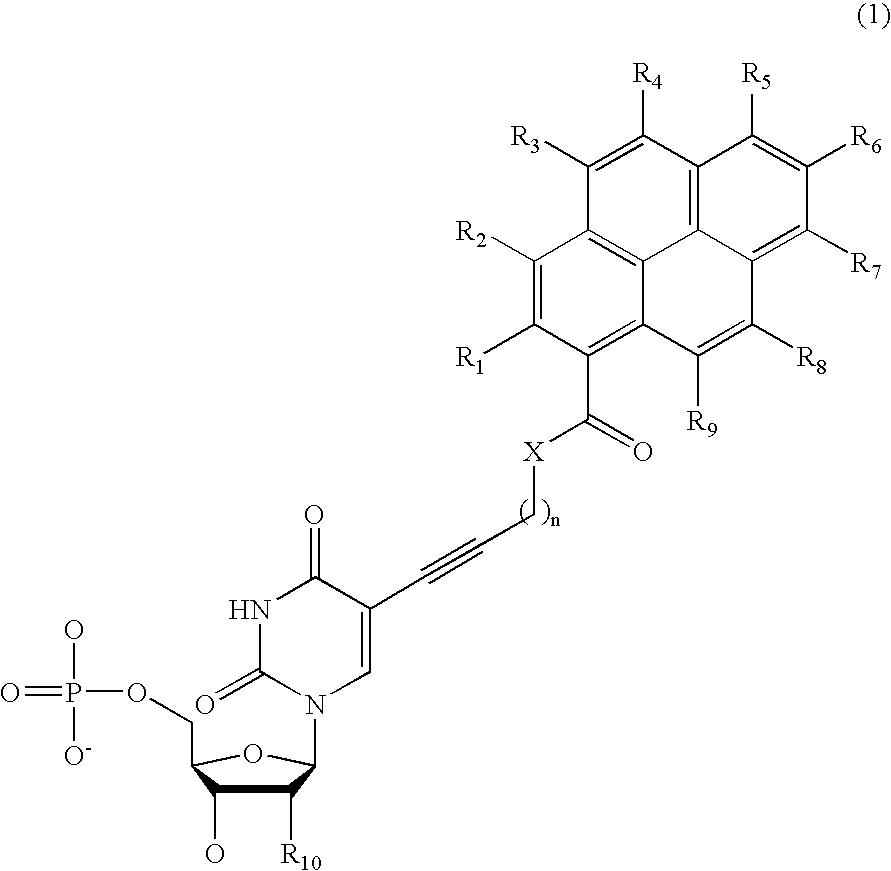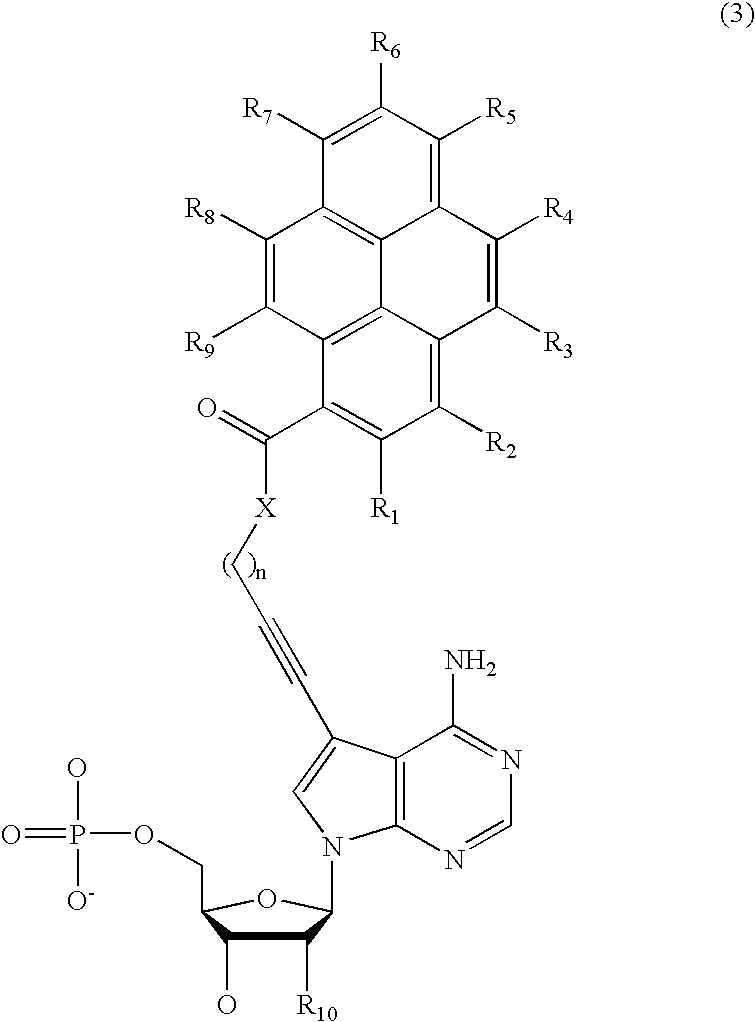Nucleotide derivative and DNA microarray
a technology of nucleotide derivatives and microarrays, applied in the field of nucleotide derivatives and dna microarrays, can solve the problems of inability to avoid measurement errors, time and expense, and require substantial work, and achieve the effect of simple and reliable determination and simple and reliable investigation
- Summary
- Abstract
- Description
- Claims
- Application Information
AI Technical Summary
Benefits of technology
Problems solved by technology
Method used
Image
Examples
example 1
Synthesis of Nucleotide Derivatives (PyU(5), PyC(5), PyA(7))
[0103] According to FIGS. 6 and 7, nucleotide derivatives (PyU(5), PyC(5), PyA(7)) were synthesized as follows. The number of a compound corresponds to the: number in FIGS. 6 and 7.
[0104] Scheme i (Synthesis of Compound 2)
[0105] Propargylamine (1, Wako Pure Chemical Industries, Ltd.) and 1-pyrenecarboxylic acid (2, Aldrich) (1:1) were stirred for 2.5 hours at room temperature in N,N-dimethylformamide in the presence of a condensing agent PyBOP (1 equivalent, NOVA Biochem), extracted and purified by a column chromatography to obtain Product 2 (91%).
[0106] Scheme ii (Synthesis of Compound 4:PyU(5) Nucleoside Derivative)
[0107] Compound 3 (obtained by stirring 3-iodo-2'-deoxyuridine (Sigma) with 4,4'-dimethoxytrityl chloride (Tokyo Kasei Kogyo Co., Ltd.) in pyridine) and Compound 2 (1:1) were stirred for 10 hours at room temperature in N,N-dimethylformamide in the presence of (tetrakistriphenylphosphine)palladium (0.15 equivale...
example 2
Synthesis of Nucleotide Derivative (PyG(8))
[0128] According to FIG. 8, a nucleotide derivative. (PyG(8)) was synthesized as follows. The number of a compound corresponds to the number in FIG. 8.
[0129] Scheme 1 (Synthesis of Compound 2)
[0130] As a starting material, 1-bromopyrene was employed and subjected to Sonogashira coupling with trimethylsilylacetylene to give Compound 1. Then, the trimethylsilyl group as a protective group was removed using sodium methoxide in methanol to obtain Compound 2 (yield: 70%).
[0131] Scheme 2 (Synthesis of Compound 6:PyG(8) Nucleoside Derivative)
[0132] 2'-Deoxyguanosine was combined with N-bromosuccinimide and reacted in water to obtain Compound 3 (yield: 60%). Then, the hydroxyl groups in 3- and 5-positions in Compound 3 were protected with t-butyldimethylsilyl group using t-butyldimethylsilyl chloride and imidazole, and then subjected to Sonogashira coupling with Compound 2 to obtain Compound 5 (yield: 61%). The t-butyldimethylsilyl group as the pro...
example 3
Synthesis of Oligonucleotides
[0135] Using the oligonucleotide derivatives prepared in Example 1 (PyU(5), PyC(5), PyA(7)) and the nucleotide derivative prepared in Example 2 (PyG(8)), oligodeoxyribonucleotides containing the nucleotide derivatives were synthesized. The oligodeoxyribonucleotides were synthesized in accordance with an ordinary phosphoramidite method using a 392DNA / RNA synthesizer of Applied Biosystems Japan Ltd. The cleavage from the solid carrier and the deprotection were accomplished by incubation for several hours in 25% ammonia, followed by purification by a high pressure liquid chromatography.
PUM
| Property | Measurement | Unit |
|---|---|---|
| temperature | aaaaa | aaaaa |
| emission wavelengths | aaaaa | aaaaa |
| emission wavelengths | aaaaa | aaaaa |
Abstract
Description
Claims
Application Information
 Login to View More
Login to View More - R&D
- Intellectual Property
- Life Sciences
- Materials
- Tech Scout
- Unparalleled Data Quality
- Higher Quality Content
- 60% Fewer Hallucinations
Browse by: Latest US Patents, China's latest patents, Technical Efficacy Thesaurus, Application Domain, Technology Topic, Popular Technical Reports.
© 2025 PatSnap. All rights reserved.Legal|Privacy policy|Modern Slavery Act Transparency Statement|Sitemap|About US| Contact US: help@patsnap.com



